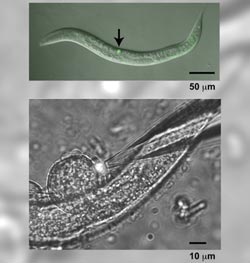Moving Targets

Migrating cells in a nematode are identified and stained green in the top image. Looking closer, the glowing cell is extracted for analysis using a glass pipette.<br> <br>[Credit: Caltech / Mihoko Kato]<br>
At any given moment, millions of cells are on the move in the human body, typically on their way to aid in immune response, make repairs, or provide some other benefit to the structures around them. When the migration process goes wrong, however, the results can include tumor formation and metastatic cancer.
Little has been known about how cell migration actually works, but now, with the help of some tiny worms, researchers at the California Institute of Technology (Caltech) have gained new insight into this highly complex task.
The team's findings are outlined this week online in the early edition of the Proceedings of the National Academy of Sciences (PNAS).
“In terms of cancer, we know how to find primary tumors and we know when they're metastatic, but we're missing information on the period in between when cells are crawling around, hanging out, and doing who knows what that leads to both of these types of diseases,” says Paul Sternberg, Thomas Hunt Morgan Professor of Biology at Caltech, and corresponding author of the paper.
To learn more about those crawling, or migrating, cells, Sternberg looked at the animal he knows best—the tiny Caenorhabditis elegans, a common species of roundworm that he has been studying for many years. Despite their small size, the worms actually share quite a few genes with humans.
“Migration is such a conserved process,” says Mihoko Kato, a senior research fellow in biology at Caltech and a coauthor of the paper. “So whether it happens in C. elegans or in mammals, like humans, we think that many of the same genes are going to be involved.”
Contained in each cell—be it human or worm—are thousands of genes, all of which have a special job, or jobs, to do. Of these genes, roughly one-third are active in a given cell. To see what genes are expressed during migration, Sternberg and Kato, along with Erich Schwarz, a research fellow in Sternberg's lab, studied a single cell, called the linker cell (LC), in the worms; during reproductive development, LCs travel almost the entire length of the worm's body.
Using high-powered microscopy, the team identified LCs at two intervals, 12 hours apart, during the worm's larval stage, and removed them from the animals. Then, using sequencing and computational analysis, they determined the genes that were actively expressed at these two migration time points. This method of study is called transcriptional profiling.
“By understanding the normal migration of a single cell, we can understand something about how the cells are programmed to navigate their environment,” says Sternberg, who is also an investigator with the Howard Hughes Medical Institute. “Our view of cancer metastasis is that the tumor cells confront some obstacle and then they have to evolve to get through or around that obstacle. The way they probably do that is by using some aspect of the normal program that exists somewhere in the genome.”
He says that learning more about different ways that cells migrate may lead to the development of new types of drugs that block this process by targeting specific genes. The team plans additional transcriptional profiling studies to obtain more detailed information about the functions of particular C. elegans genes involved in migration—and, eventually, of similar genes in higher organisms, including humans.
“We selected genes present in both worms and humans, but which have not been studied much before us,” says Schwarz. “Since we found that some of these genes help worm LCs migrate, we think each one may have a related human gene helping cells migrate, too.”
“The nice thing about this technology is that you can use it with any cell type,” adds Kato, who points out that their studies have already helped identify new functions for known genes possessed by both the worms and humans. “It's a similar process to do transcriptome profiling using human cells.”
In addition to identifying drug targets, the team is also hoping to find a good signature, or molecular marker, for migrating cells. “This kind of information could be very useful diagnostically, to help identify cells that are doing things that they shouldn't be doing, or weird combinations of genes that shouldn't be expressed together, which is what a tumor cell might have,” says Sternberg. “This work lays the foundation for really understanding what information is critically needed from mammalian cells for tumor cells to be able to migrate.”
The study, “Functional transcriptomics of a migrating cell in Caenorhabditis elegans,” was funded by the National Institutes of Health and the Howard Hughes Medical Institute.
Written by Katie Neith
Brian Bell
bbell2@caltech.edu
Media Contact
More Information:
http://www.caltech.eduAll latest news from the category: Life Sciences and Chemistry
Articles and reports from the Life Sciences and chemistry area deal with applied and basic research into modern biology, chemistry and human medicine.
Valuable information can be found on a range of life sciences fields including bacteriology, biochemistry, bionics, bioinformatics, biophysics, biotechnology, genetics, geobotany, human biology, marine biology, microbiology, molecular biology, cellular biology, zoology, bioinorganic chemistry, microchemistry and environmental chemistry.
Newest articles

Security vulnerability in browser interface
… allows computer access via graphics card. Researchers at Graz University of Technology were successful with three different side-channel attacks on graphics cards via the WebGPU browser interface. The attacks…

A closer look at mechanochemistry
Ferdi Schüth and his team at the Max Planck Institut für Kohlenforschung in Mülheim/Germany have been studying the phenomena of mechanochemistry for several years. But what actually happens at the…

Severe Vulnerabilities Discovered in Software to Protect Internet Routing
A research team from the National Research Center for Applied Cybersecurity ATHENE led by Prof. Dr. Haya Schulmann has uncovered 18 vulnerabilities in crucial software components of Resource Public Key…





















